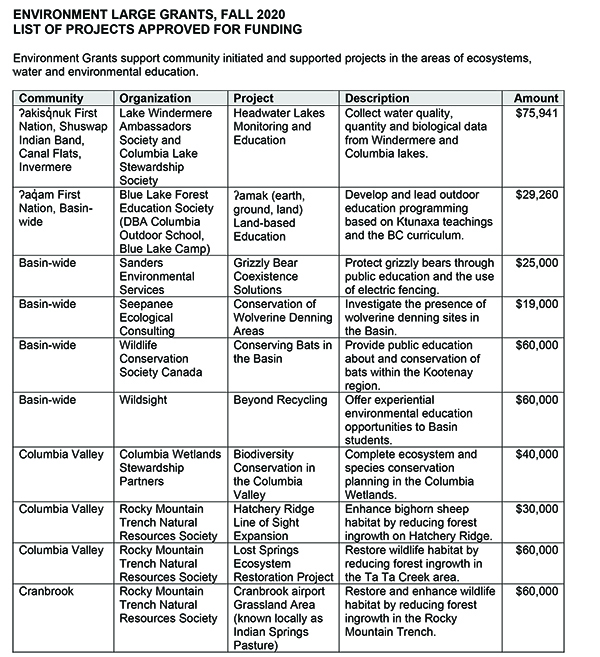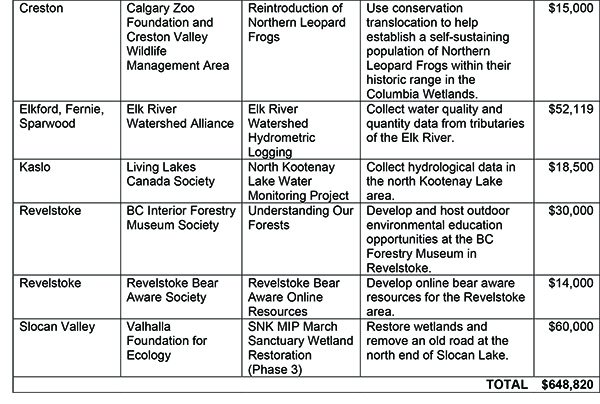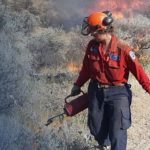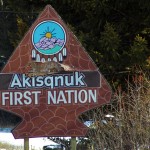Home »

Trust supports 16 projects with nearly $650,000
 Basin environmental projects support innovation, education and conservation
Basin environmental projects support innovation, education and conservation
From frogs to grizzly bears and creeks to lakes, habitats and species of all shapes and sizes will benefit from 16 environmental initiatives around the Columbia Basin. The projects are supported by nearly $650,000 from the Columbia Basin Trust’s Environment Grants.
“These grants will support people of the Basin to better understand and celebrate nature, study ecological changes taking place, as well as creating on-the-ground improvements to the environment,” said Brianna Burley, Manager, Environment with the Columbia Basin Trust. “Monitoring and restoration of sensitive ecosystems, land-based education built on partnerships with Indigenous community groups, and species reintroduction are just some of the community-driven projects we are proud to support.”
The Trust’s Environment Grants program helps fund projects that focus on ecosystems, water and environmental education.
 Connecting All Living Things (ʔa·kxam̓is q̓api qapsin) Through Outdoor Education
Connecting All Living Things (ʔa·kxam̓is q̓api qapsin) Through Outdoor Education
The community of ʔaq̓am, ʔaq̓amnik’ Elementary School, key Ktunaxa Nation Council staff and Columbia Outdoor School are partnering to develop programs that highlight history, culture and current stewardship practices when it comes to the environment. Students will connect to their surroundings while considering and respecting traditional and current Indigenous ways of thinking and doing.
“With help from ʔaq̓am staff and community, we will aid in the transfer of Indigenous teachings to the outdoors by building a progressive, culturally aligned curriculum that will help teachers throughout the Basin deliver outdoor programming,” said Shonna Murphy, Director of Programs, Columbia Outdoor School.
“While connecting to the land, students will also build leadership skills, develop positive self-identity and share their personal skills and traditional knowledge.”
Conservation Efforts for Wetlands and Watershed Habitats

Adding logs for painted turtles to bask on and upgrading abandoned beaver dams to help wetlands retain water are two activities the Columbia Wetlands Stewardship Partners will support.
The larger task, however, will be to determine which areas in the Columbia Wetlands are “biodiversity hotspots” that need to be focused on first so conservation efforts are delivered where they’re needed most.
“To protect species-at-risk, ungulates and predators in the Columbia Wetlands, we also need to protect the upland watersheds and habitats that those species need for their survival,” said Suzanne Bayley, President of the Columbia Wetlands Stewardship Partners.
“The habitats we will focus on are those affected by development or climate change here in the valley, or those which offer species a refuge from climate change elsewhere.”
Remediating Grasslands for Ecosystem Resilience

The grasslands area located near Canadian Rockies International Airport in the Rocky Mountain Trench will undergo environmental restoration to support ecosystem resilience.
The Rocky Mountain Trench Natural Resources Society will remove some of the Douglas fir and ponderosa pine that are encroaching on the grasslands, manually and through prescribed burns, as well as manage invasive plants, inventory American badger habitat and create “wildlife trees” that appeal to species that use features like holes or loose bark.
“Thanks to decades of fire suppression, trees have gradually encroached upon these grasslands,” said Marc Trudeau, Coordinator with the Rocky Mountain Trench Natural Resources Society. “This project will mitigate this shift, while also helping to create a more resilient ecosystem by reintroducing fire to the landscape and reducing the chance of a catastrophic wildfire.”
Columbia Basin Trust supports the ideas and efforts of the people in the Columbia Basin. To learn more about the Trust’s programs and initiatives, and how it helps deliver social, economic and environmental benefits to the Basin, visit ourtrust.org.
Riverside Forest Walk Adds Educational Components

Near Revelstoke, a wander along the Riverside Forest Walk might reveal a dinner plate orchid, cedar tree scratched to shreds by squirrels or a stump riddled with woodpecker holes. Soon visitors to this section of the BC Interior Forestry Museum will learn even more as they enjoy these trails. The Society that runs the museum is developing an educational program, including a self-guided tour with brochures and signage, that will focus on topics like tree identification, how Indigenous peoples use native plants and how humans and the environment interact.
“We hope to foster a better understanding of the interconnectedness of community and environmental health, and show that knowledge of the land helps people make sound natural resource management decisions,” said Barb Wadey, Secretary of the BC Interior Forestry Museum.
“Through this project and this unique forest space, we aim to create an environment of mental well-being and connection with nature.”
Lead image: The community of ʔaq̓am, ʔaq̓amnik’ Elementary School, Ktunaxa Nation Council staff and Columbia Outdoor School will develop outdoor environmental education programs that highlight history, culture and stewardship, with support from Columbia Basin Trust. Columbia Basin Trust photos









